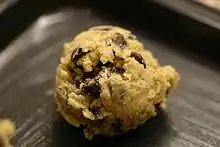Cookie dough
Cookie dough refers to a blend of cookie ingredients which has been mixed into a malleable form that has not yet been cooked by heat. The dough is then separated and the portions baked as individual cookies, or eaten as it is.

Cookie dough can be homemade or bought pre-made in packs (frozen logs, buckets, etc.). Desserts containing cookie dough, such as ice cream, candy, and milkshakes are also frequently marketed and sold. Pre-made cookie doughs may be sold in different flavors.
When being made at home, the recipe can consist of common ingredients, including flour, butter, white sugar, salt, vanilla extract, and eggs. Because the dough is not baked, no leavening agents, such as baking soda or baking powder are used. If cookie dough is intended to be used to bake cookies then baking soda or baking powder gets added to the dough. Chocolate chip cookie dough is a popular variation which can be made by adding chocolate chips to the mix.
Health risks
Because of the presence of raw egg and raw flour, the consumption of uncooked cookie dough increases the possibility of contracting foodborne illness. The U.S. Food and Drug Administration (FDA) strongly discourages the consumption of all food products containing raw egg or raw flour because of the threat from disease-causing bacteria such as Salmonella and E. coli. Two tablespoons of milk can be swapped for eggs in cookie recipes, and two cups of flour can be microwaved for 50–60 seconds to get rid of any bacteria. Leavening, such as baking powder or baking soda can be removed. Doing this will allow the cookie dough to be edible.[1][2][3][4]
There have been a number of outbreaks related to consumption of cookie dough and pathogens in flour. For example, raw flour was found to be the culprit in a June 2009 E. coli outbreak involving Nestlé Toll House prepackaged cookie dough, which was recalled; more than 7,000 people fell ill as a result, although none died.[5][6] In 2010, Nestle decided to switch to heat-treated processing for all flour used in producing cookie dough.[7] In 2016, General Mills recalled flour and cake mixes because of E. coli found in the raw flour.[8] In 2015, there was a recall of certain Blue Bell Ice Cream products due to Listeria monocytogenes found in the facility that produces cookie dough for the ice cream's chocolate chip cookie dough and other cookie dough containing flavors.[9]
Edible cookie dough
Cookie dough designed specifically for eating raw (such as that found in ice cream) is made without raw eggs and uses heat-treated flour to reduce the presence of microbial pathogens.[10]
Edible cookie dough, egg-free and made with specially treated flour, became a dessert trend and led to the creation of several businesses. Some sweet shops sell multiple desserts with cookie dough as only one option, and others solely create and sell dough.[11]
References
- Mary Ann Anderson (22 March 2008). "Deceptively delicious egg cocktails". McClatchy-Tribune News Service. Retrieved 8 July 2008.
- Scott, Jenny (June 2016). "Raw Dough's a Raw Deal and Could Make You Sick". Food and Drug Administration.
- "Flour, Raw Dough, and Raw Batter". FoodSafety.gov. Retrieved 29 November 2017.
- Ashley Welch (30 June 2016). "Why the FDA is warning you not to eat raw cookie dough". CBS News.
- "The Surprising Ingredient in Raw Cookie Dough That Could Make You Sick". NPR. Retrieved 29 November 2017.
- Layton, Lyndsey; Gaudio, Greg (30 June 2009). "FDA Confirms Presence of E. coli in Nestle Cookie Dough". The Washington Post. Retrieved 30 April 2010.
- "Nestle to begin using heat-treated flour".
- "General Mills: 2016 flour recall consumer Information". Retrieved 29 November 2017.
- "FDA Investigates Listeria monocytogenes in Ice Cream Products from Blue Bell Creameries". Food and Drug Administration. 10 June 2015.
- Hadley Malcolm, Is any cookie dough safe to eat?, USA Today (1 July 2016).
- Kaufman, Joanne (21 June 2017). "Raw Nostalgia: Cookie Dough Is the Latest Dessert Trend". The New York Times. ISSN 0362-4331. Retrieved 23 June 2017.
External links
 Media related to Cookie dough at Wikimedia Commons
Media related to Cookie dough at Wikimedia Commons